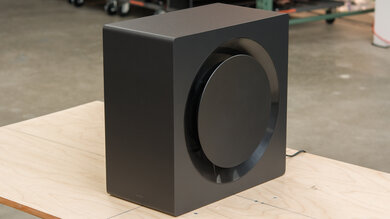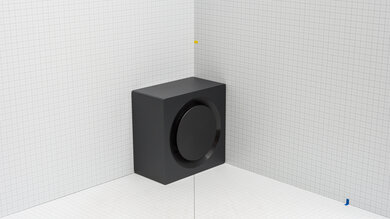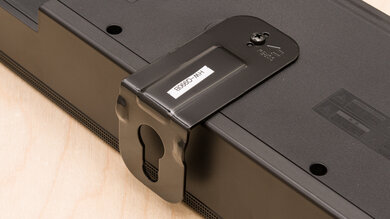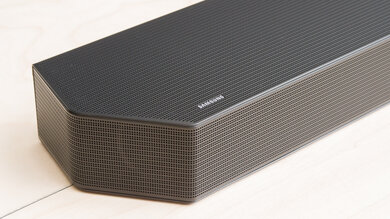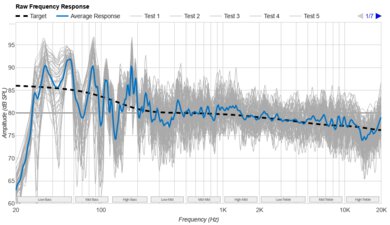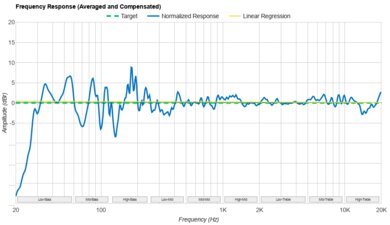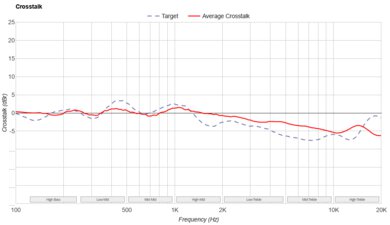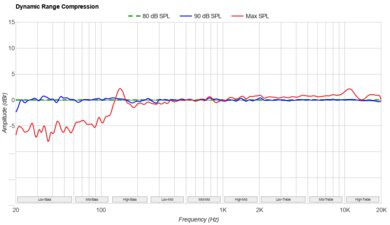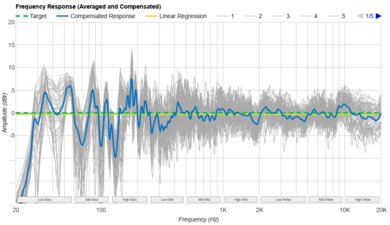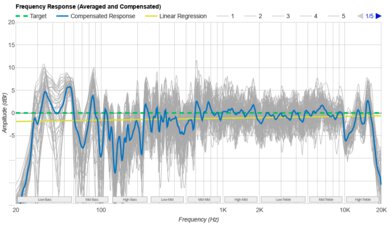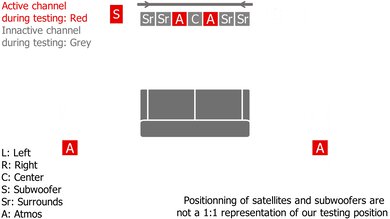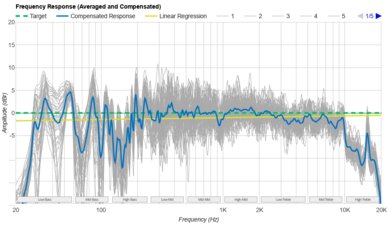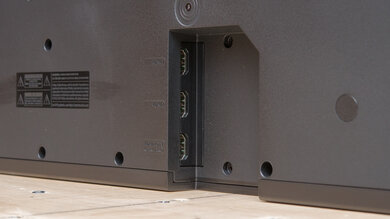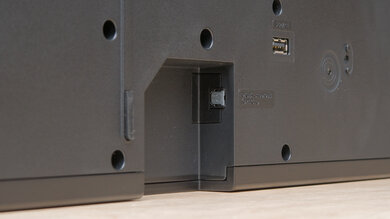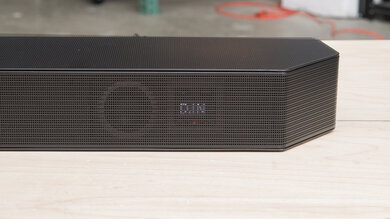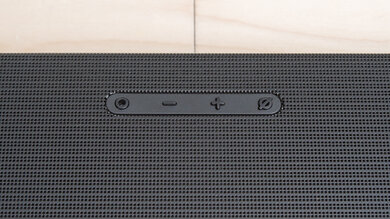The Samsung HW-Q800D is a 5.1.2 soundbar that features wireless Dolby Atmos support and some trademark Samsung features, like SpaceFit Sound for room calibration and Q-Symphony, which works with the built-in speakers in compatible Samsung TVs to produce a more immersive sound. That said, compared to last year's Samsung HW-Q800C, which has similar specs, any updates featured in this 2024 model are incremental at best. Support for Chromecast is now universal rather than region-locked, plus it has support for Bluetooth 5.2, but beyond that, there is little to report beyond these changes.
Our Verdict
The Samsung HW-Q800D is great for mixed usage. With wireless support for Dolby Atmos, this soundbar covers a lot of ground, whether you're using it for movies, TV shows, or gaming. The dedicated sub helps bring out boom and rumble in everything from 808 kicks to on-screen explosions. Dialogue and speech are rendered with detail and clarity, too, thanks to a discrete center channel, and can be enhanced using the 'Active Voice Amplifier' feature. With support for sound formats like Dolby Digital and DTS, as well as game-centric features like 4k passthrough at 60Hz, this bar can handle almost anything you throw at it.
- Great bass extension.
- Gets loud in 'Standard' mode.
- Dolby Atmos support.
- 4k HDMI passthrough at 60Hz.
- Some compression at max volume.
The Samsung HW-Q800D is excellent for dialogue-heavy content, like TV shows. Its 5.1.2 setup features a discrete center channel that can help accentuate voices within a densely crowded mix. The bar can reproduce mid and treble frequencies in great detail, aided by a few sound enhancement features, including 'Active Voice Amplifier,' which analyzes the audio signal in real-time to ensure voices remain clear, and the more standard 'Voice Enhance' and 'Night' modes.
- Gets loud in 'Standard' mode.
- Dolby Atmos support.
- Some compression at max volume.
The Samsung HW-Q800D is great for music. Its dedicated subwoofer helps amp up basslines and kicks in songs, while the bar itself outputs detailed mids and smooth highs that can help bring out nuances in vocals and lead instruments. The SpaceFit Sound feature helps adjust the output to get the best out of the unique acoustic characteristics of your room, too, so music should sound vibrant regardless of whether you keep your setup in your basement or living room. That said, there's a fair bit of compression at max volume, particularly in the bass range, so audio quality can suffer when you crank the bar up.
- Great bass extension.
- Gets loud in 'Standard' mode.
- Some compression at max volume.
The Samsung HW-Q800D is impressive for movies. Thanks to its dedicated sub, it's capable of outputting rumbling bass that lends itself well to tense action sequences. The detailed mid and treble ranges, as well as the discrete center channel, mean dialogue and speech sound crisp, too. Using 'Standard' mode, it can get pretty loud without compressing. That said the soundstage and surround sound performance leave a little to be desired, though this can be improved using the 'Adaptive Sound' mode. While the up-firing drivers create some impression of height when listening to Atmos content, the audio never feels like it's coming from directly above you.
- Great bass extension.
- Gets loud in 'Standard' mode.
- Dolby Atmos support.
- Some compression at max volume.
- Mediocre height performance.
Changelog
-
Updated Jul 30, 2025:
We referenced the Samsung HW-Q800F in the Dimensions - Subwoofer box.
-
Updated May 28, 2025:
We've updated this review to add a comparison with the LG S90TY in the Height (Atmos) box.
-
Updated Mar 10, 2025:
We've updated this review to correct an error regarding EQ bands. This soundbar has access to a 7-band EQ, not a 10-band EQ.
-
Updated Mar 07, 2025:
We added a reference to the LG S80TR in the Dimensions - Satellites box.
Check Price
Differences Between Sizes And Variants
The Samsung HW-Q800D comes in just one color variant: 'Black.' You can see our unit's label here. If you encounter a different variant of this soundbar, please let us know in the comments, and we'll update our review.
Popular Soundbar Comparisons
The Samsung HW-Q800D is a 5.1.2 soundbar, released in 2024, with support for Dolby Atmos. It's the next generation of the Samsung HW-Q800C, although the 2024 model features incremental updates at best. Both its features and performance are remarkably similar to the previous generation, with the only notable additions being universal Chromecast support and Bluetooth 5.2. It lacks some of the more premium features seen in the flagship Samsung HW-Q990D, too, like support for HDMI 2.1 and 4k at 120Hz passthrough gaming.
If you're looking for more soundbars, check out our recommendations for the best soundbars, the best Dolby Atmos soundbars, and the best soundbars for movies.
The Sonos Arc is a standalone bar that works well for smaller homes where space is at a premium, but it lacks the rumble and boom that's brought by the Samsung HW-Q800D's dedicated subwoofer. It's fair to say that the Samsung performs better overall: it has a more balanced sound, can get louder, and is better built, with more sound enhancement features available. Gamers will also appreciate having an HDMI In port, as well as 4k passthrough capabilities at 60Hz, which aren't present in the Sonos. That said, the Sonos' default preset has a slightly wider soundstage than the Samsung's 'Standard' mode, and there's less compression at max volume with the Sonos. All in all, unless you're in a tight space and can't make too much noise, it's worth opting for the cheaper Samsung.
The Samsung HW-Q800C and the Samsung HW-Q800D have extremely similar performance and feature sets, with only minor tweaks made to the 2024 model. They have an almost identical design, using sleek plastic and mesh. They're both 5.1.2 bars compatible with Dolby Atmos and come with some proprietary Samsung features, like Q-symphony—which works with compatible Samsung TVs to produce a more immersive sound. While both bars can passthrough 4k signals at 60Hz, they lack HDMI 2.1 compatibility, which those with current-gen gaming consoles may miss. Otherwise, the only notable differences are that the Q800D now features built-in Chromecast support that's not region-locked and Bluetooth version 5.2. If these extra features aren't important to you, it's worth picking up the previous generation when it goes on sale.
The Samsung HW-Q800D is a more compact setup than the LG S80TR, as it lacks satellite speakers and has a narrower bar that fits more easily between TV stand legs. Both bars have generally well-balanced frequency responses but excel in different areas. The LG offers a more immersive soundstage with better performance, while the Samsung delivers better Atmos support. Both include a range of sound enhancement features and get loud enough for the average living room.
It's splitting hairs to choose between the Samsung HW-Q800F and the Samsung HW-Q800D. If you have the Q800D, it's probably not worth upgrading to the Q800F. Both are 5.1.2-channel soundbars that deliver immersive Dolby Atmos audio without requiring a full rear speaker setup. The Q800F offers a shorter, more compact subwoofer that's easier to place in tight spaces. The Q800F is also Roon Ready. Unless you need the updated features just listed, buy whichever bar you can find for cheaper.
Test Results





